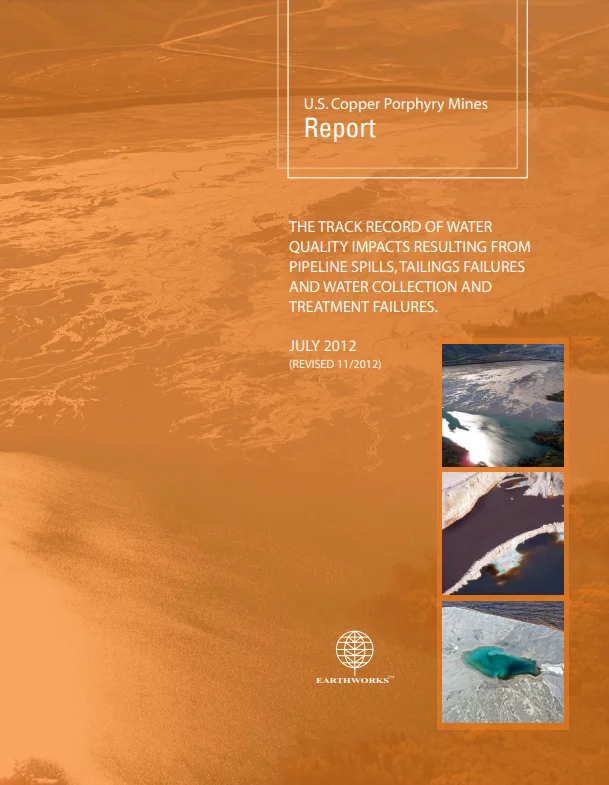Revised Nov 2012
From the report:
The Pebble Mine is proposed for development at the headwaters of the Bristol Bay watershed in southwest Alaska, which supports the world’s largest wild sockeye salmon fishery. According to current ore estimates, the Pebble Mine would be the largest copper porphyry mine in the U.S., if constructed.
Currently, the U.S. Environmental Protection Agency (EPA) is completing a watershed assessment to evaluate the potential impacts of large-scale mining on water quality and fishery resources using a mine scenario that reflects the expected characteristics of mining operations at the Pebble deposit.
The purpose of this report is to compile the record of pipeline, seepage control and tailings impoundment failures at operating copper porphyry mines in the U.S., and to document associated water quality impacts.
We reviewed state and federal documents and a federal database for fourteen copper porphyry mines currently operating in the U.S. with respect to three failure modes: pipeline spills or other accidental releases, tailings spills or tailings impoundment failures, and failure to capture and treat mine seepage.
The 14 mines represent 87% (14 out of 16) of currently operating copper porphyry mines, and 89% of U.S. copper production in 2010 – the most recent data on copper production available from the U.S. Geological Survey. The mines were chosen based on an operating record of more than five years. These mines provide a representative view of the types of environmental impacts resulting from the development of copper porphyry deposits, focusing on pipeline spills, tailings failures, and water collection and treatment failures.
Our research shows that copper porphyry mines are often associated with water pollution
associated with acid mine drainage, metals leaching and/or accidental releases of toxic
materials. We found that all of the mines experienced at least one failure, with most mines
experiencing multiple failures:
- At 14 of the 14 mines (100%), pipeline spills or other accidental releases occurred. The most frequent spills were reported at the Ray Mine in Arizona, where over fifty pipeline spills occurred from 1988 to 2012. Examples of recent pipeline spills include a 2012 spill at the Ray Mine which washed tailings into the Gila River, and a 2008 pipeline spill at the Morenci Mine of 186,000 gallons of sulfuric acid along two miles of Chase Creek – a tributary of the San Francisco River.
- At 13 of the 14 mines (92%), water collection and treatment systems have failed to control contaminated mine seepage, resulting in significant water quality impacts. The development of acid mine drainage was associated with the most severe and lasting impacts. For example, at the Tyrone and Chino mines – the two largest copper porphyry mines in New Mexico, seepage from tailings impoundments and waste rock piles have resulted in surface and/or groundwater pollution. The State of New Mexico and U.S. Department of Justice have filed natural resource damage claims against the company for damages to water, fish and wildlife resources.
- At 4 out of 14 mines (28%), partial tailings impoundment failures have occurred, and at 9 out of 14 mines (64%), tailings spills have occurred. These included a 1997 partial failure of the tailings impoundment at the Pinto Valley Mine, where 8.1 acres of creek bed and surrounding upland were buried under material as deep as 42 feet. In 1993, heavy precipitation caused the Gila River to flood and breach the tailings impoundment at the Ray Mine, carrying pollutants 11 miles downriver. And in 1980, 2.6 million cubic yards of tailings were released at the Tyrone mine, and flowed 8 kilometers downstream.
CONCLUSION:
Our research shows that water quality impacts to surface and/or groundwater are common at currently operating copper porphyry mines in U.S., resulting from three failure modes (pipeline spills or other accidental releases, failure to capture and treat mine seepage, and tailings spills or impoundment failures).
These failures resulted in a variety of environmental impacts, such as contamination of drinking water aquifers, contamination and loss of fish and wildlife and their habitat, and risks to public health. In some cases, water quality impacts are so severe that acid mine drainage will generate water pollution in perpetuity.
This research demonstrates that the three failure modes identified in the Bristol Bay watershed assessment with respect to risks to water quality are reasonable and well-supported by the track record of operating copper porphyry mines in the U.S.
Many of the currently operating copper porphyry mines are located in the arid southwest, where precipitation is limited, and communication between surface and groundwater resources is limited. While beyond the scope of the analysis in this report, more significant impacts could be expected at mines in wetter climates, with abundant surface water and shallow groundwater, such as is the case in the Bristol Bay region. Research shows that mines with high acid generating potential and in close proximity to surface and groundwater are at highest risk for water quality impacts.



